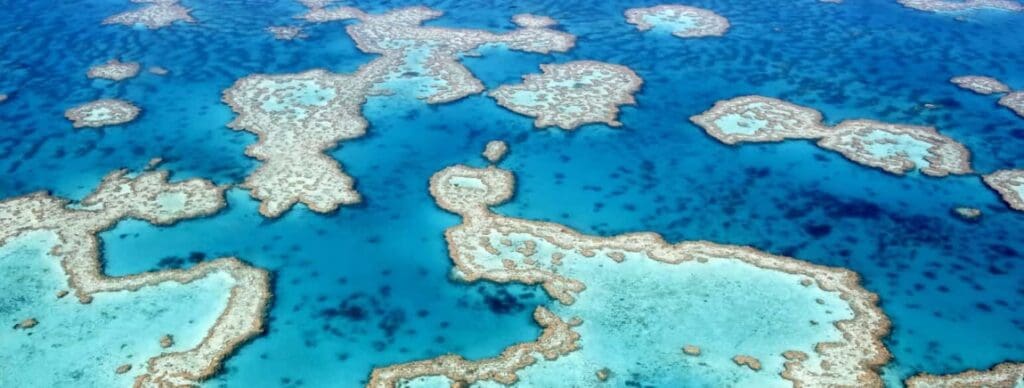Explore the latest insights from top science journals in the Muser Press daily roundup (June 30, 2025), featuring impactful research on climate change challenges.
In brief:
Study reveals uneven land sinking across New Orleans, raising flood-risk concerns
The study, published in Science Advances, used satellite radar data to track subtle shifts in ground elevation across Greater New Orleans between 2002 and 2020. The study found that some neighborhoods, wetlands and even sections of floodwalls are sinking by more than an inch per year – with some areas experiencing up to 47 millimeters (nearly 2 inches) of elevation loss annually.
“In a city like New Orleans, where much of the land is already near sea level, even minor drops in elevation can increase flood risk,” said Simone Fiaschi, lead author of the study and a former researcher with Tulane’s Department of River-Coastal Science and Engineering, now employed at TRE-Altamira.
The findings underscore how both natural and human-driven forces are reshaping the city’s landscape. Causes of the sinking – known as subsidence – include natural soil compaction, groundwater pumping, industrial development and the legacy of wetland drainage for urban growth.

The study used a remote sensing technique called InSAR (Interferometric Synthetic Aperture Radar), which detects millimeter-scale changes in land surface elevation by comparing satellite radar images taken over time. This allowed the researchers to build the most detailed map yet of vertical land motion in New Orleans – including areas like wetlands that had previously lacked reliable data.
Among the most troubling findings: some of the concrete floodwalls and levees built to protect the city after Katrina are themselves sinking. In a few cases, parts of the Hurricane and Storm Damage Risk Reduction System (HSDRRS) are losing elevation faster than sea levels are rising, reducing their capacity to block storm surges.
“These results are a wake-up call,” said co-author Prof. Mead Allison, also of Tulane. “We need ongoing monitoring and maintenance to ensure that our flood defenses don’t lose their level of protection beneath us.”
The study also found pockets of sinking around industrial sites, the airport and newer residential developments – areas where soil compression and groundwater withdrawal are likely contributors. In contrast, some areas such as parts of Michoud showed modest land uplift, likely due to the halt of industrial groundwater pumping and recovery of the water table.
Wetlands east of the city, long known for their ecological importance, are also sinking rapidly in places. In some spots, the loss of elevation could transform marshes into open water within a decade if trends continue. This has implications not just for wildlife but also for storm protection, as wetlands help buffer storm surges.
New Orleans, much of which lies below sea level, relies on an elaborate system of levees, pumps and drainage canals to keep water out. As sea levels rise and the ground sinks, the margin for error narrows.
Experts say that without sustained monitoring, including satellite data and ground-based measurements, it’s difficult to know where to reinforce levees or how to plan for future storms.
“This research shows that land movement isn’t uniform, and understanding these patterns is crucial for protecting lives and property in a city where inches truly matter,” Fiaschi said. “However, it’s crucial to remember that our results still require careful ground-truthing. This is especially true for critical areas like the floodwalls, where on-site verification was not possible during this project.”
The study highlights the potential of satellite monitoring to guide infrastructure maintenance and urban planning, not just in New Orleans but in coastal cities worldwide facing similar challenges.
Journal Reference:
Simone Fiaschi et al., ‘Vertical land motion in Greater New Orleans: Insights into underlying drivers and impact to flood protection infrastructure’, Science Advances 11, eadt5046 (2025). DOI: 10.1126/sciadv.adt5046
Article Source:
Press Release/Material by Tulane University
Solar energy as a basic service for the public
What do we need to achieve the energy transition? The technologies for producing and storing renewable energies are available and are constantly improving. The challenge lies in implementation. How do we bring business, politics, and the public, with their sometimes conflicting interests, under one (solar) roof? Empa researchers Harald Desing, Hauke Schlesier, and Marcel Gauch from the Technology and Society laboratory have developed a proposal on how the energy transition could be implemented quickly, sustainably, and in a socially acceptable manner – whether worldwide, in Switzerland, or just in a single municipality.
The study was published in the journal Progress in Energy.
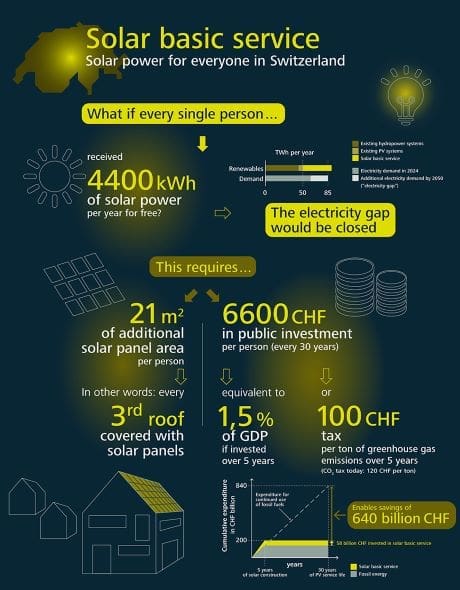
The researchers call their model the “solar basic service“. At its core is the idea that every person should receive a personal solar power budget of 500 watts (equivalent to 4,400 kilowatt hours per year) – financed by the general public. “Many essential services are already provided as basic services, such as roads, education, water supply, and sewage systems. So why not also the foundation for the energy transition?,“ asks Harald Desing, the study‘s lead author.
“Foundation” is an important keyword. The solar basic service does not mean that the government should cover all of society’s energy needs free of charge. The 500 watts are sufficient – at least in Switzerland – to close the electricity gap created by the elimination of fossil fuels. However, the model proposed by the Empa researchers does not provide for public energy storage. This means that public solar power is only freely available when the sun is shining.
This restriction fulfills two important functions: On the one hand, it is intended to motivate individuals and companies to adjust their behavior and consume electricity primarily when it is available free of charge. The researchers refer to this as a “sunflower society,” which, like its namesake, always turns toward the sun. On the other hand, the omission of storage saves (public) money. “The construction of storage facilities increases the price tag for the energy transition,” says Desing. “That’s why, in our model, energy storage is not part of the basic service but rather a convenience that will require further private investments.”
Feasible within five years
Since 500 watts is slightly more than is needed to cover basic energy requirements, citizens can sell their unused energy. One possible scenario would be to use the energy equivalents as a means of payment for electric mobility or public transport. People who consume little energy would thus benefit most – an important social balancing factor, according to the researchers. “Today, the state uses subsidies to incentivize the energy transition,” says Desing. “But only the wealthy part of our society benefits from this, because you must be a landowner and provide the remaining capital. In our model, tenants and people without large savings also benefit from the joint investment.”
The researchers have calculated what it would mean in concrete terms to make solar basic service a reality in Switzerland. 500 watts of solar power correspond to approximately 21 square meters of solar surface area per person. “That would amount to about every third roof in Switzerland,” says Desing. Parking lots, noise barriers, and unused areas along motorways and railway lines could also be considered for this purpose.
Desing emphasizes that it is important to mostly use already developed areas for the installation of solar panels and not to convert new land for this purpose. This is another reason why the basic service is based on solar energy: Photovoltaics can be installed quickly, easily, and in a decentralized manner; they blend in well with the cityscape, require little maintenance, and cause neither noise nor visual impairment.
In order to build a “public solar power plant” in Switzerland within five years, an investment of around 58 billion Swiss francs would be necessary. This corresponds to approximately 1% of Switzerland’s gross domestic product over five years – comparable to annual investments in roads (source) or double the military expenditure (source). The investment would pay for itself within six to seven years of commissioning – even though the public solar power plant is not designed to make a profit.
“End consumers currently spend around 20 billion Swiss francs per year on fossil fuels in total. The basic solar service provides enough electricity to reduce this expenditure to zero.” The researchers estimate that the cost of regularly renewing the public solar power plant would amount to around 6,600 Swiss francs per person every 30 years.
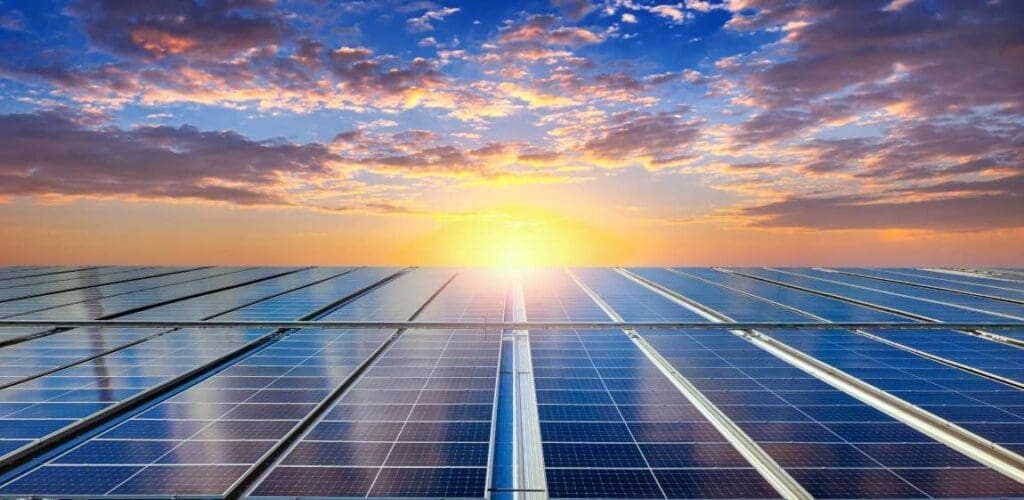
Securing materials and a skilled workforce
Even if it is entirely feasible, installing a solar power plant of this size would not come without challenges. One is finding skilled workers. The researchers are calling for the plant to be built as quickly as possible so that the benefits of abandoning fossil fuels can be reaped sooner. Around 50,000 workers would be needed to convert Switzerland to basic solar power within five years. However, only a fraction of these workers would need an extensive training. The majority of the installation work can be carried out competently after just a few weeks of training.
“There are already so-called solar camps where you can learn how to install solar panels in a very short time,” says Desing. The researcher also envisions a “solar year” in which young people work for the common good, for example as an alternative to military or civil service. Another advantage is that while Swiss funds flow abroad for fossil fuels, a large part of the investment in solar systems – namely the installation costs – would remain in Switzerland.
The materials needed for the panels pose another challenge – but researchers are convinced that this too can be solved. The main component of the cells, silicon, is the most common element in the Earth’s crust and is found everywhere in the world. More critical are silver, tin, and aluminum, which are used as conductors, solder, and frame and mounting materials, respectively. The demand for tin and aluminum can be greatly reduced by improving the design of the panels.
Research is currently being conducted into substitute materials for silver – but this would not even be necessary for the construction of the public solar plant: “There is more silver in cutlery drawers worldwide than would be needed to provide 500 watts of solar power for everyone on Earth,” says Desing. The production of solar panels, which currently takes place mainly in China, could be relocated to Europe as part of the transition, thereby strengthening local industry.
Reversing climate change
The model described in the study is an initial proposal and flexible in many respects, says Harald Desing. Its exact implementation must be clarified in public discourse. The great advantage of the solar basic service is that any municipality, canton, or country implementing it would benefit immediately and directly. However, for the model to have the intended effect, a number of points must be given special consideration. “Free energy should not tempt people to waste it,” warns Desing. “Moreover, the development of the solar basic service must go hand in hand with the phasing-out of fossil fuels.” Special attention must also be paid to social fairness.
The researcher is convinced that solar basic service would make investments in other renewable energies such as wind and water more attractive, as they complement solar energy and are also available when solar power is scarce. Further expansion of solar capacity would also be worthwhile in certain cases.
“The more solar capacity we have, the more electricity we can harvest at off-peak times or in bad weather, when solar panels deliver lower yield,” explains Desing. And when the sun shines again? “The surplus electricity could be used to remove historic CO2 emissions from the atmosphere and process them into carbon-binding materials.” This is also currently a topic of research at Empa as part of the Mining the Atmosphere initiative.
Journal Reference:
Harald Desing, Hauke Schlesier and Marcel Gauch, ‘Solar basic service – an idea for just acceleration of the energy transition’, Progress in Energy 7, 023002 (2025). DOI: 10.1088/2516-1083/adc370
Article Source:
Press Release/Material by Anna Ettlin | Swiss Federal Laboratories for Materials Science and Technology (Empa)
When rain, snow, and soil align: The triple threat behind 2024’s deadly central Asian floods
The past year of 2024 was characterized by repeated runs of extreme rainfall and floods worldwide. Among these, one of the most devastating events was the Central Asian flood in the spring of 2024. From the end of March to April 2024, extensive flooding impacted large areas of Kazakhstan and neighboring southwestern Russia, which was reported as the worst flooding in the area for at least 70 years.
The floods resulted in widespread devastation, leaving dams breached and overflowing reservoirs. More than 118,000 people were evacuated and over 12,000 residential buildings were flooded. The damage was estimated to exceed USD 623 million for Kazakhstan, surpassing the total cumulative damage from water-related disasters over the past 30 years.
In a recent study published in Advances in Atmospheric Sciences, an international team of scientists led by Dr Wenxia Zhang at the Institute of Atmospheric Physics, Chinese Academy of Sciences (IAP/CAS), unravel the driving mechanisms underlying this record-breaking flood event.
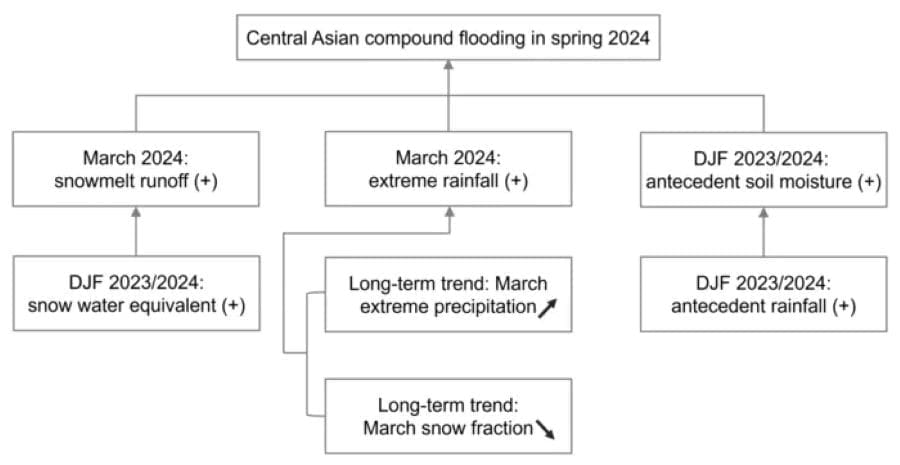
“The record-breaking floods were contributed by both long-term climate warming and interannual variability, with multiple climatic drivers at play across the synoptic to seasonal timescales”, said Lan Li, PhD candidate at the IAP/CAS, contributing author of the study.
First, the heavy snowmelt in March 2024 was associated with above-normal preceding winter snow accumulation. Second, extreme rainfall was at a record-high during March 2024, in line with its increasing trend under climate warming. Third, the snowmelt and extreme rainfall in March were compounded by record-high soil moisture conditions in the preceding winter, which was a result of interannual variability and related to excessive winter rainfall over Central Asia. Thus, this record-breaking flood event was a typical compound extreme event, exacerbated by extreme rainfall, heavy spring snowmelt and record-high soil moisture pre-conditions.
“As climate warming continues, the interplay between the increasing trend of extreme rainfall, interannual variations in soil moisture pre-conditions, as well as shifting timing and magnitudes of spring snowmelt, will further escalate and complicate spring flooding risks. This is a growing and widespread challenge for the mid- to high-latitude regions,” added Zhang. “Such complexity poses significant challenges to predictions and projections of compound floods. To improve this, we need to better understand the long-term changes of individual drivers as well as their interactions.”
Journal Reference:
Zhang, W., Li, L., Zhou, T. et al., ‘Central Asian Compound Flooding in 2024 Contributed by Climate Warming and Interannual Variability’, Advances in Atmospheric Sciences (2025). DOI: 10.1007/s00376-025-4425-6
Article Source:
Press Release/Material by Institute of Atmospheric Physics (IAP) | Chinese Academy of Sciences (CAS)
Scientists reveal timeline and uneven evolution of endemic flora on Qinghai-Tibet plateau
A team of researchers led by Prof. Wang Wei from the Institute of Botany of the Chinese Academy of Sciences (IBCAS) has revealed how unique native plant life on the Qinghai-Tibet Plateau (QTP) has evolved over time, shedding new light on the origins and development of one of the world’s most biologically diverse temperate regions.
The study was published in PNAS.
The QTP, comprising three subregions – the Plateau Platform, the Himalaya, and the Hengduan Mountains – is home to two global biodiversity hotspots. It supports the richest temperate flora on Earth and exhibits an exceptionally high degree of endemism. However, these fragile mountain ecosystems are increasingly threatened by global warming and human disturbance, making it critical to understand their evolutionary history for effective conservation planning.
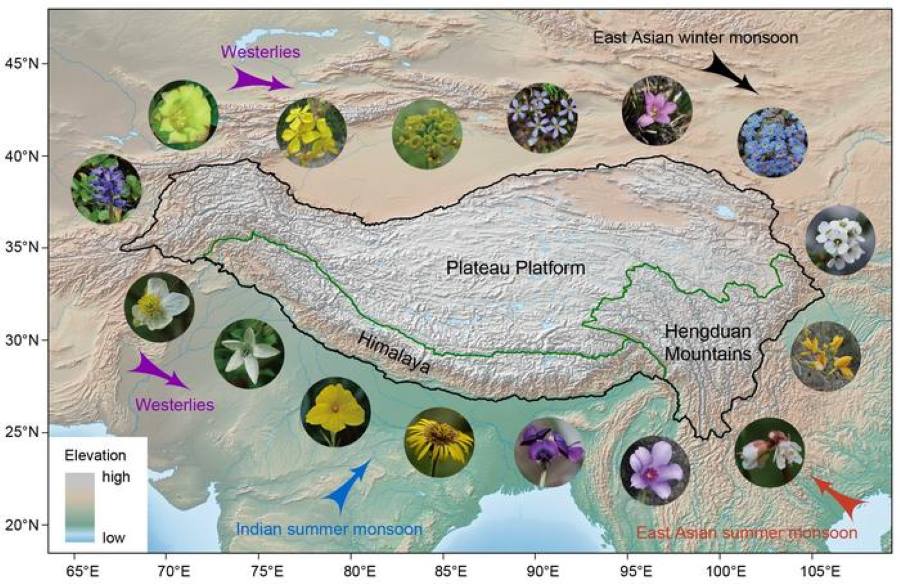
In this study, the researchers selected 37 land plant clades with 1,740 species covering all 82 genera endemic to the QTP. They found that the origins of these endemic genera were most likely driven by ecological niche and elevation differentiation, caused by the uplift of the QTP and associated climate change.
The researchers suggest that QTP floristic endemism emerged by the Early Eocene, and the unique biodiversity of the QTP reflects both species that evolved locally and those that migrated in from elsewhere.
In addition, the study shows that among the three subregions of the QTP, the processes associated with floristic endemism are asynchronous, reflecting different geoclimatic events – with the Miocene as a particularly critical period.
“We found that the origin of QTP floristic endemism dates back to the Early Eocene, which is much earlier than the prevailing view of when this flora first appeared,” said Prof. Wang, corresponding author of the study. “Both long-term in situ speciation and immigration have been responsible for the assembly of the endemic flora of the QTP, but their contributions in the three subregions appear markedly different.”
The study also highlights the Hengduan Mountains as a crucial center of endemism. Identified as hosting the oldest endemic lineages and functioning as both a “pump” and a “sink” of biodiversity, this region emerges as a top conservation priority for future biodiversity protection efforts.
Journal Reference:
G. Cao, X. Li, J. Zhang, H. Peng, H. Li, A.S. Erst, F. Jabbour, R.D.C. Ortiz, P.S. Soltis, D.E. Soltis & W. Wang, ‘Cenozoic geoclimatic changes drove the evolutionary dynamics of floristic endemism on the Qinghai–Tibet Plateau’, Proceedings of the National Academy of Sciences U.S.A. 122 (26) e2426017122 (2025). DOI: 10.1073/pnas.2426017122
Article Source:
Press Release/Material by Chinese Academy of Sciences (CAS)
Featured image credit: Gerd Altmann | Pixabay




